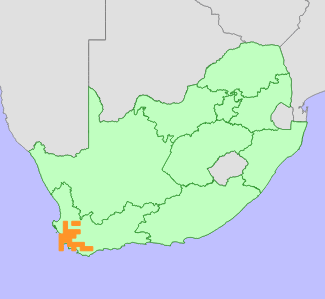|
Scientific Name | Drosera pauciflora Banks ex DC. |
Higher Classification | Dicotyledons |
Family | DROSERACEAE |
Synonyms | Drosera acaulis in sense of Raym.-Hamet, not of L.f. (misapplied name), Drosera grandiflora Bartl. |
Common Names | Doublom (a), Snotblom (a), Vliegvangertjie (a) |
National Status |
Status and Criteria | Least Concern |
Assessment Date | 2018/10/04 |
Assessor(s) | L. von Staden |
Justification | Drosera pauciflora is a widespread species, with an extent of occurrence (EOO) of 17 158 km². It is still common in spite of extensive habitat loss. It continues to decline, but is not yet in danger of extinction, and is therefore listed as Least Concern. |
Distribution |
Endemism | South African endemic |
Provincial distribution | Western Cape |
Range | This species is endemic to South Africa, particularly to the Western Cape's coastal lowlands, from Piketberg to Caledon. |
Habitat and Ecology |
Major system | Terrestrial |
Major habitats | Peninsula Shale Fynbos, Swartland Alluvium Fynbos, Lourensford Alluvium Fynbos, Leipoldtville Sand Fynbos, Atlantis Sand Fynbos, Cape Flats Sand Fynbos, Hangklip Sand Fynbos, Elim Ferricrete Fynbos, Boland Granite Fynbos, Kouebokkeveld Alluvium Fynbos, Kouebokkeveld Shale Fynbos, Swartland Shale Renosterveld, Cape Winelands Shale Fynbos, Elgin Shale Fynbos, Greyton Shale Fynbos, Swartland Silcrete Renosterveld, Swartland Granite Renosterveld, Peninsula Shale Renosterveld, Western Ruens Shale Renosterveld, Central Ruens Shale Renosterveld, Ceres Shale Renosterveld, Peninsula Granite Fynbos |
Description | It occurs on damp loamy or sandy flats. |
Threats |
| Drosera pauciflora has lost more than 80% of its habitat to crop cultivation and urban expansion. Habitat loss and degradation continues. Most subpopulations persist on isolated remnants, where they are threatened by competition from dense infestations of alien invasive plants. |
Population |
In spite of extensive habitat loss, this species is still very common. The population however continues to decline due to ongoing habitat loss and degradation.
|
Population trend | Decreasing |
Assessment History |
Taxon assessed |
Status and Criteria |
Citation/Red List version | | Drosera pauciflora Banks ex DC. | Least Concern | Raimondo et al. (2009) | |
Bibliography |
Goldblatt, P. and Manning, J.C. 2000. Cape Plants: A conspectus of the Cape Flora of South Africa. Strelitzia 9. National Botanical Institute, Cape Town.
Manning, J.C. and Goldblatt, P. 2012. Plants of the Greater Cape Floristic Region 1: The Core Cape Flora. Strelitzia 29. South African National Biodiversity Institute, Pretoria.
Obermeyer, A.A. 1970. Droseraceae. In: L.E. Codd, B. De Winter, D.J.B. Killick and H.B. Rycroft (eds). Flora of southern Africa 13:187-201. National Botanical Institute, Pretoria.
Raimondo, D., von Staden, L., Foden, W., Victor, J.E., Helme, N.A., Turner, R.C., Kamundi, D.A. and Manyama, P.A. 2009. Red List of South African Plants. Strelitzia 25. South African National Biodiversity Institute, Pretoria.
|
Citation |
| von Staden, L. 2018. Drosera pauciflora Banks ex DC. National Assessment: Red List of South African Plants version 2024.1. Accessed on 2025/11/14 |
 Comment on this assessment
Comment on this assessment

